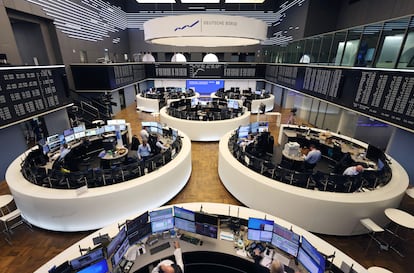Are European stocks finally outperforming Wall Street?
European share prices started the year on a positive note, trading at lower valuations, but analysts caution against confirming a trend shift

Analysts concur that European stocks are notably more affordable than U.S. equities. For instance, the stocks in the Stoxx Europe 600 are valued at 14 times earnings, while those in the S&P 500 trade at 25 times annual earnings. Michele Morganti, senior equity strategist at Generali Investments, said this significant difference is the largest in over 20 years.
It seems like European equities might now be bucking this trend as they have been slightly outperforming Wall Street this year, with the Euro Stoxx up by 12.4% compared to the S&P 500′s 9.5% since January. However, it’s still early to confirm a trend shift. Over the past year, U.S. stocks have surged twice as much as European stocks. Looking back to the early 2000s, U.S. markets saw a 256% increase, while the Stoxx Europe 600 only rose by 42%.
The U.S. stock market surge is largely due to the dominance of tech stocks, which now account for 36% of the S&P 500 index’s movement. These include the well-known Magnificent Seven companies – Amazon, Apple, Alphabet, Meta, Nvidia and Tesla. There’s also a group of major European companies known for strong performance and generous dividends that Goldman Sachs dubbed the Granolas, an acronym for GlaxoSmithKline, Roche, ASML, Nestlé, Novartis, Novo Nordisk, L’Oreal, LVMH, AstraZeneca, SAP and Sanofi.
Mark Denham, head of European equities at Carmignac, says these European equities are valued for other reasons beyond performance and dividends. “We think that having a wider range of sectors in Europe should be a good thing. European companies also have a strong global presence. Approximately 60% of European companies’ sales occur outside Europe, whereas it’s around 30% for American companies.” Andrew Heiskell, a strategist at Wellington Management, warns that the current dominance of technology stocks in the U.S. indices “constitutes a significant risk in the event of a change in market confidence spurred by interest rates and risk aversion.” Heiskell also notes that shareholder payments, such as dividends and share buybacks, are currently higher in Europe compared to the United States.
Another analyst who likes European stocks is Janus Henderson’s Tom Lemaigre. “Europe excels in manufacturing, a skill overlooked during the tech and easy-money focus of the past decade. Opportunities for European equities, both structurally and thematically, are promising. With the market at its cheapest, Europe may offer higher returns than the U.S.”
A key argument for Wall Street supporters is the recent release of last year’s business results and the 2024 forecasts. Earnings per share in the U.S. grew by an average of 7.2% in 2023, with sales increasing by 4.1%. In contrast, European business profits remained stagnant overall, despite improvement in the last quarter of 2023. But other experts question this perceived advantage. “The Magnificent Seven added around 12% to annual earnings per share growth in the United States, meaning that without them this growth would have been negative,” said Wolf von Rotberg, an equity strategist at J. Safra Sarasin. But this argument also supports further investment in these tech giants. “The latest quarterly results from tech companies, especially Nvidia, Oracle, Microsoft, Intel, Adobe and Meta, further back their valuations,” said Jaime Medem of Mirabaud Wealth Management in Spain.
Forecasts for the future
When looking at forecasts for 2024 and beyond, many analysts still prefer the U.S. “This market has outperformed the European market for over a decade, despite its consistently higher prices,” said Daniel Pingarrón, head of sales at Natixis. “American companies are projected to outperform European ones in 2024, with the S&P 500 expecting a 10% profit growth compared to Europe’s 5%. The U.S. benefits from stronger economic growth and looser monetary policy, while Europe faces risks due to geopolitical conflicts and reliance on the Chinese economy, making its stocks more volatile.”
Interest rates are a key factor in making for market bets. Jens Ehrhardt, founder of DKE Kapital, sees better chances for lower rates in Europe than the U.S. “Europeans should actually lower interest rates before Americans for the first time. Yet, greater [monetary policy] independence seems highly improbable.”
Finally, Álvaro Antón of Abrdn offers advice on how Europe can regain its appeal for investors. “Business profits should align with affordable valuations, while European firms need to deliver strong profit growth and enduring stability marked by profitability and growth. This recipe can make Europe appealing to investors once more.” Still, the eagerly anticipated strong performance of European equities remains surprisingly steady for the moment.
Sign up for our weekly newsletter to get more English-language news coverage from EL PAÍS USA Edition
Tu suscripción se está usando en otro dispositivo
¿Quieres añadir otro usuario a tu suscripción?
Si continúas leyendo en este dispositivo, no se podrá leer en el otro.
FlechaTu suscripción se está usando en otro dispositivo y solo puedes acceder a EL PAÍS desde un dispositivo a la vez.
Si quieres compartir tu cuenta, cambia tu suscripción a la modalidad Premium, así podrás añadir otro usuario. Cada uno accederá con su propia cuenta de email, lo que os permitirá personalizar vuestra experiencia en EL PAÍS.
¿Tienes una suscripción de empresa? Accede aquí para contratar más cuentas.
En el caso de no saber quién está usando tu cuenta, te recomendamos cambiar tu contraseña aquí.
Si decides continuar compartiendo tu cuenta, este mensaje se mostrará en tu dispositivo y en el de la otra persona que está usando tu cuenta de forma indefinida, afectando a tu experiencia de lectura. Puedes consultar aquí los términos y condiciones de la suscripción digital.
More information
Archived In
Últimas noticias
Most viewed
- Sinaloa Cartel war is taking its toll on Los Chapitos
- Oona Chaplin: ‘I told James Cameron that I was living in a treehouse and starting a permaculture project with a friend’
- Reinhard Genzel, Nobel laureate in physics: ‘One-minute videos will never give you the truth’
- Why the price of coffee has skyrocketed: from Brazilian plantations to specialty coffee houses
- Silver prices are going crazy: This is what’s fueling the rally









































